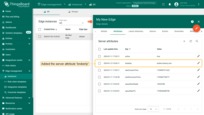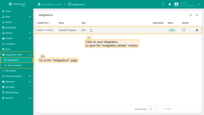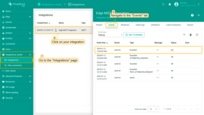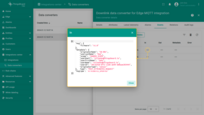- Prerequisites
- Create converter and integration templates
- Modify Edge Root Rule Chain for downlinks
- Assign Integration to Edge
- Send uplink message
- Send downlink message to device
- Next steps
MQTT Integration allows connecting to external MQTT brokers, subscribe to data streams from those brokers, and convert any type of payload from your devices to the ThingsBoard Edge message format. It is typically used when your devices are already connected to an external MQTT broker or any other IoT platform or connectivity provider with MQTT based backend.
To learn more, please see the integration diagram.
ThingsBoard Edge MQTT Integration acts as an MQTT client. It subscribes to topics and converts the data into telemetry and attribute updates. In the case of a downlink message, MQTT Integration converts it to the device-appropriate format and pushes it to an external MQTT broker.
Prerequisites
In this tutorial, we will use:
- ThingsBoard Professional Edition account;
- Locally installed ThingsBoard PE Edge instance;
- MQTT broker that can be accessed through the ThingsBoard Edge instance: broker.hivemq.com (port 1883);
- mosquitto_pub and mosquitto_sub MQTT clients for sending and receiving messages.
- a sensor device that sends temperature readings. In this guide we’ll use SN-001 to ‘tb-edge/mqtt-integration-tutorial/sensors/SN-001/temperature’ and is subscribed to ‘tb-edge/mqtt-integration-tutorial/sensors/SN-001/rx’ to receive RPC calls. We will send a message with temperature readings in a simple format:
{"value":25.1}
Create converter and integration templates
Only the ThingsBoard Professional Edition creates converters and integration templates. So please use ThingsBoard Cloud or install your own platform instance to log in as a Tenant administrator.
Follow the steps below to add the MQTT integration:
- Go to theEdge management > Integration templates section and click the “plus” button to add a new integration. Select the “MQTT” type. Name it “Edge HTTP Integration”. Then click Next;

- The next step is to create an Uplink data converter.
The purpose of the decoder function is to parse the incoming data and metadata into a format that ThingsBoard can consume. deviceName and deviceType are required, while attributes and telemetry are optional. Attributes and telemetry are flat key-value objects. Nested objects are not supported.
For this example, use the code below.
One can use either TBEL (ThingsBoard expression language) or JavaScript to develop user defined functions. We recommend utilizing TBEL as it’s execution in ThingsBoard is much more efficient compared to JS.
|
Now copy & paste the following script to the Decoder function section:
|
|
Now copy & paste the following script to the Decoder function section:
|
- The next step is to create a Downlink converter.
The downlink converter transforms an outgoing RPC message and then the Integration sends it to external MQTT broker. You can customize a downlink according to your configuration. Let’s consider an example where we send an attribute update message.
For this example, use the code below.
One can use either TBEL (ThingsBoard expression language) or JavaScript to develop user defined functions. We recommend utilizing TBEL as it’s execution in ThingsBoard is much more efficient compared to JS.
|
Now copy & paste the following script to the Encoder function section:
|
|
Now copy & paste the following script to the Encoder function section:
|
Finally, we go to the “Connection” page.
- You can use the placeholder ${{ATTRIBUTE_KEY}} to replace an integration field with an attribute value from a specific Edge entity. In this example, we will use the placeholder ${{brokerIp}} for ‘Host’ and 1883 for ‘Port’.
- Add a topic filter:
1
tb-edge/mqtt-integration-tutorial/sensors/+/temperature
- You can also select an MQTT QoS level. level. By default, we use MQTT QoS level 0 (at most once);

- Go to the ‘Advanced settings’. It is better to uncheck the ‘Clean session’ parameter. Many brokers do not support sticky sessions, so they will silently close the connection if you try to connect with this option enabled;
- Let’s leave the ‘Downlink topic pattern’ by default, which means that the integration will take the metadata.topic and use it as the downlink topic;
- Click the “Add” button to create the integration.

Modify Edge Root Rule Chain for downlinks
We can send a downlink message to the device from the Rule chain using the rule node. To send downlink via integration, modify the Edge Root Rule chain.
We’ll need to add two rule nodes: ‘originator fields’ and ‘integration downlink’ nodes.
- Go to the Edge management > Rule chain templates section and click the Edge Root Rule Chain to open it.
- Create an originator fields node. Configure to add originator name and originator type to the message metadata - in the downlink converter, the device name is used to set the correct downlink MQTT topic.
- Create an integration downlink node. Specify your integration in its settings;
- Set the Attributes Updated and Post attributes links from the message type switch node to the originator fields node. And set the Success link from the originator fields node to the integration downlink node. When the attribute is created or changes are made to the attribute on the Edge, the downlink message will be sent to the integration. Apply the changes.




Assign Integration to Edge
Once the converter and integration templates are created, we can assign the Integration template to the Edge. Since we are using the placeholder ${{brokerIp}} in the integration configuration, we must first add the attribute brokerIp to the Edge. You need to provide the IP address of the MQTT broker. We use the public URL ‘broker.hivemq.com’ in this tutorial, but it could be any internal IP address as well. Once the attribute is added, we are ready to assign and verify the integration.
- Go to the Edge management > Instances section, click on your edge instance to open "Edge details" window, and navigate to the "Attributes" tab. To add a new server attribute to **Edge**, click the "plus" button.
- Name it brokerIp and set the value as "broker.hivemq.com". Then click the "Add" button.
- The "brokerIp" server attribute is now added to the edge.
- Now, click "Manage edge integrations" icon of Edge entity;
- Click the "+" button at the top right of the corner. Select your integration from the drop-down menu and click the "Assign" button.
- Login to your ThingsBoard Edge instance and go to the Integrations center > Integrations section. You should see your integration. Click on it.
- In the "Integration details" window, the ${{brokerIp}} placeholder will be replaced with the value of the attribute.







Send uplink message
To send an uplink message, use the following command. It simulates a device sending temperature readings to the integration:
1
mosquitto_pub -h broker.hivemq.com -p 1883 -t "tb-edge/mqtt-integration-tutorial/sensors/SN-001/temperature" -m '{"value":25.2}'
Now, go to the Integrations center > Integrations section and select the “Events” tab in your MQTT integration on the ThingsBoard Edge. If you have done everything correctly, you will find an uplink message with the OK status. To see the message, click the three dots in the “Message” column.


When you send the message, a new device is created. The created device with data can be seen in the Entities > Devices section:

You can also view the received data in the uplink converter. In the In and Out blocks of the “Events” tab:



Send downlink message to device
Now let’s check the downlink functionality. Open a terminal window and run the following command:
1
mosquitto_sub -h broker.hivemq.com -p 1883 -t "tb-edge/mqtt-integration-tutorial/sensors/+/rx"
Keep this terminal running in the background. In this terminal window, you should receive incoming messages sent later by the integration.

Now let’s add a shared attribute ‘firmware’. Go to the Devices page, select your device, and navigate to the “Attributes” tab on the ThingsBoard Edge. To create a new attribute, select the “Shared attributes” scope and click the “plus” button. Then set the attribute name, its value (for example, the key name is ‘firmware’, value: ‘v1.0’) and save the data.

An example of incoming messages from ThingsBoard Edge in the terminal:

To ensure that the downlink message is sent to the integration, you can check the “Events” tab of the integration:


Received and sent data can be viewed in the downlink converter. The “In” block of the Events tab shows what data has been entered, and the “Out” field shows the message sent to the device:
Here 1



Here 2
Next steps
-
Getting started guide - Provide quick overview of main ThingsBoard Edge features. Designed to be completed in 15-30 minutes:
-
Installation guides - Learn how to setup ThingsBoard Edge on various available operating systems and connect to ThingsBoard Server.
-
Edge Rule Engine:
-
Rule Chain Templates - Learn how to use ThingsBoard Edge Rule Chain Templates.
-
Provision Rule Chains from cloud to edge - Learn how to provision edge rule chains from cloud to edge.
-
- Security:
- gRPC over SSL/TLS - Learn how to configure gRPC over SSL/TLS for communication between edge and cloud.
-
Features:
-
Edge Status - Learn about Edge Status page on ThingsBoard Edge.
-
Cloud Events - Learn about Cloud Events page on ThingsBoard Edge.
-
-
Use cases:
-
Manage alarms and RPC requests on edge devices - This guide will show how to generate local alarms on the edge and send RPC requests to devices connected to edge:
-
Data filtering and traffic reduce - This guide will show how to send to cloud from edge only filterd amount of device data:
-
- Roadmap - ThingsBoard Edge roadmap.



